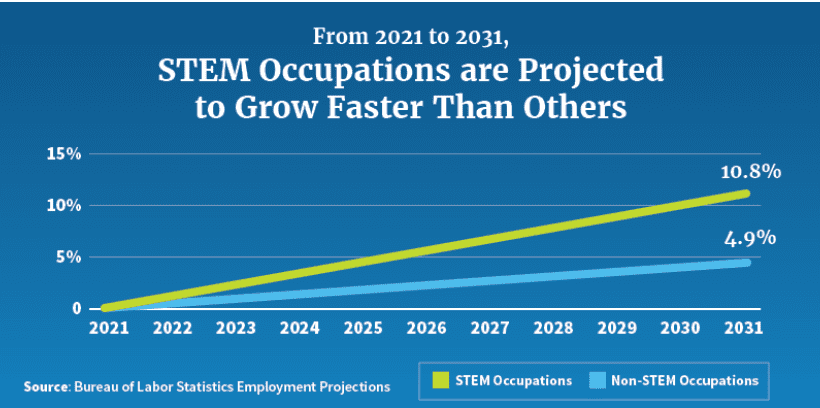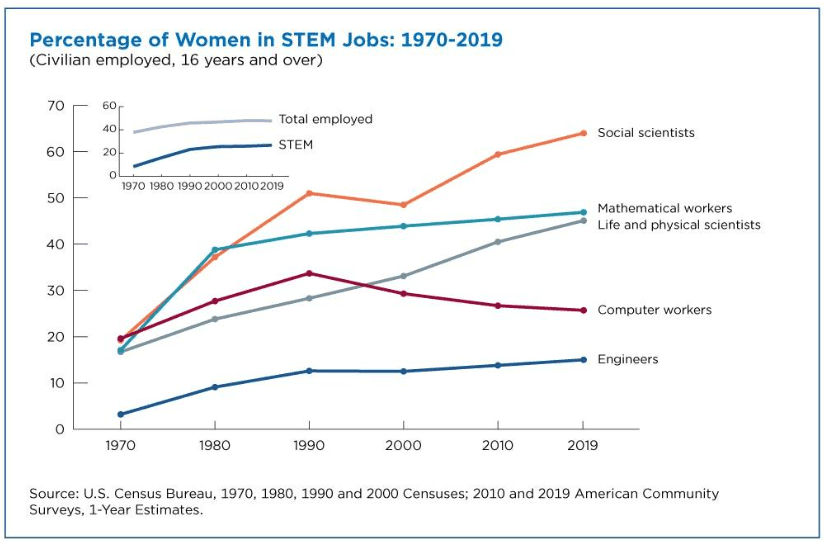Are you a woman thinking about making the move to tech?
Challenges exist for women in technical fields; however, there are significant advantages, too. If you have a passion for a career in science, technology, engineering, or math (STEM), ProWrite encourages you to follow your dreams and go for it. Both owners of ProWrite are women who have decades of experience working in a technical industry.
In this blog, we review the benefits of choosing a tech career. We also take a look at the diversity gap in the industry, and how businesses are working to close that gap. This blog offers insights into how you can make the move to a career in tech.
Let’s get started.
Why Should You Choose Tech?
By the end of this blog, you may be asking, “Why not?”
Job Growth in Tech Is Real
Since the beginning of the pandemic, people around the world have spent more time online, for work and leisure. Just think about how your online life has changed in the last few years. Think about the emerging technologies you use every day. We regularly work, shop, bank, and play online.
Studies show internet use significantly increased during the pandemic and hasn’t come back down. Many of us—in fact 90% of us—found the internet essential during the pandemic. We adopted new technologies to stay connected with loved ones and coworkers. We chat via Slack, meet via Zoom or Teams, and store our data in the virtual cloud.
Global cloud-computing market share is projected to grow from $680 billion (2023) to more than $2,432.87 billion by 2030. Businesses are also adopting artificial intelligence (AI), like robotic process automation (RPA), in manufacturing. AI streamlines processes across organizations, such as in-service delivery and customer care.
This cultural shift increased the demand for qualified people to enter computer and information technology occupations. Although U.S. tech companies have downsized in response to inflation and a post-pandemic world, job growth in the tech industry as a whole remains strong.
According to the U.S. Bureau of Labor Statistics (BLS), STEM occupations are projected to grow 11% by 2031. This is two times faster than all other occupation categories combined. The job growth in the computer and technology disciplines is even higher at 15%.

BLS reports the fastest growing tech occupations in STEM are (click on the links to read more about each occupation):
- Data Scientists
- Information Security Analysts
- Web Developers and Digital Designers
- Software Developers
- Operations Research Analysts
- Computer and Information Research Scientists
- Software Quality Assurance Analysts and Testers
In addition to the above list from BLS, CIO lists the most in-demand tech jobs for 2023.
Spending more time online and shifting to cloud-based computing increased cyberattacks, online scams, and cyber piracy. Add in AI, and you can see why the demand in tech occupations, especially in these areas, has grown.
Alternative Tech Careers
There are other tech careers that are not represented on the above lists. Tech sales support, marketing, and technical writing are alternative careers in tech. Tech writing jobs are projected to grow at 6% over the next 10 years. Women make up half of the tech writing workforce. Technical writers play an essential role in tech, communicating complex technical information to a variety of audiences.
“One of the biggest mistakes a company can make when it comes to documentation is to have their own technical experts write user guides that are intended to be read by a non-technical audience. As technical writers, we can translate tech-speak into something an everyday user can understand.” –Kelly Summers, owner of ProWrite
Not all tech jobs require a degree. Experience can be just as important. To become a web developer, you can take online courses to get certified or even teach yourself.
Did You Know Tech Pays More?
BLS estimated that the annual median salaries for STEM-related jobs were double those of non-STEM occupations (2021 statistics). The highest wage earners in STEM were computer and information systems managers, followed by architecture and engineering managers.
Women are still paid less than men. According to a National Center for Women & Information Technology (NCWIT) study, new computer science graduates are offered different salaries based on gender:
- Female graduates – $79,223 (average)
- Male graduates – $82,159 (average)
For more information on this topic, refer to What are Some Challenges for Women in Tech? later in this blog.
Do You Like to Work from Home?
If you thrive in a remote work environment, a career in tech may be a good fit.
Tech companies were forced to adopt work-from-home policies during the pandemic. Flex time continues in many companies, although there has been a trend to work onsite again. Some companies offer hybrid models, where you split your work week between the office and home.
According to a 2022 Future Forum Survey, 80% of knowledge workers, or those in tech, want the flexibility to choose where and when they work. Working moms want the flexibility to choose where they work, and minorities (classified in the report as Asian/Asian Americans, African Americans, and Latinx), reported the highest desire for flex time.
Some tech companies that offer hybrid or fully remote work models include Microsoft, Amazon, Salesforce, Slack, and Disney, among others.
Have You Heard about Health Technology for Women?
Femtech or female technology, a tech subsector, is an umbrella term for products and services that use technology to track and diagnose women’s health. The sector has been focused on younger women but is expanding to offer products and services for women of all ages.
Many femtech companies were started by women. Funding is increasing but still faces challenges. Venture capitalists, mostly men, have been uncomfortable with the topic of women’s health. Despite this, there are currently 200 femtech companies worldwide, and the number is growing.
If you are thinking about a career in tech, this subsector might provide you with the opportunity to develop products and services that can make a difference in women’s lives.
What are Some Challenges for Women in Tech?
Tech remains a male-dominated industry, although things are slowly changing.
According to BLS, women represent 57% of the overall U.S. workforce but only 26% of tech workers. Women also make less money than their male counterparts (as previously reported in this blog). For women of color, the gender gap and pay disparity is even greater.
Hired, a recruitment service company, published a 2022 study on pay wage inequality in tech. It showed that men are offered higher starting salaries than women for the same job at the same company.
The following diagram illustrates the gender gap in STEM fields.

These statistics haven’t gone unnoticed. More companies are adopting DEI (diversity, equity, and inclusion) practices. DEI is the application of fair treatment and complete participation of all employees from any background in organizations. DEI’s objective is to achieve equal opportunity for all employees. Companies that implement hiring guidelines, training, and promotion practices better serve underrepresented groups.
Statistics show companies that have 30% women leaders have a 15% increase in profitability compared with similar firms that do not have female leaders, according to the Peterson Institute for International Economics.
Intel, Johnson & Johnson, and Salesforce are some of the companies recognized for their diversity and inclusion programs. Click here for a complete list of companies, tech and otherwise, supporting diversity.
How to Make the Move to Tech
Here are a few questions to ask yourself before making the move to tech.
- What are your drivers? Do you want a high-paying job, or do you have a passion for coding, gaming, or programming AI?
- What kind of company do you want to work for? Do you want to work for a green company, non-profit, government, financial, female health, or one of the big tech companies?
- What companies are in your area? Are you willing to relocate to find the perfect job?
- Do you have a degree in a STEM field, or do you have experience that could get you in the door?
- Do you want to go to school or get a certification online?
Many organizations can help you find your way. They offer a broad range of support services to assist at any stage of your career. Some of the services include training, mentoring, education programs, and networking.
Here are a few organizations to check out:
- AnitaB.org: This organization promotes diversity and inclusion in technology. They support women in tech through conferences, mentorship programs, and research.
- Girls Who Code: This organization teaches girls to code and offers mentorships.
- Black Girls CODE: This non-profit organization introduces young women of color to skills in computer programming and technology.
- Women Who Tech: This organization supports women in technology by providing mentorship, networking opportunities, and funding for women-led startups.
“Growing up, I never felt that being female was a disadvantage. However, my experience has shown that there can be hidden obstacles that women sometimes need to navigate and overcome to make sure we are given equal opportunities.” –Darlena Kelley, owner of ProWrite
As a woman, you can find prospects for career growth and financial gain by going tech. There are real challenges, but don’t let those stop you. With the demand for qualified professionals in tech, there is no better time than now for you to make the move.
The owners of ProWrite, both women with decades of experience in tech, encourage you to follow your passion and enter the field. Whether you choose a career in data science, cybersecurity, or technical writing, you can make a difference.
At ProWrite, we are excited to support women who are making the move to tech.
Posted in Blog
